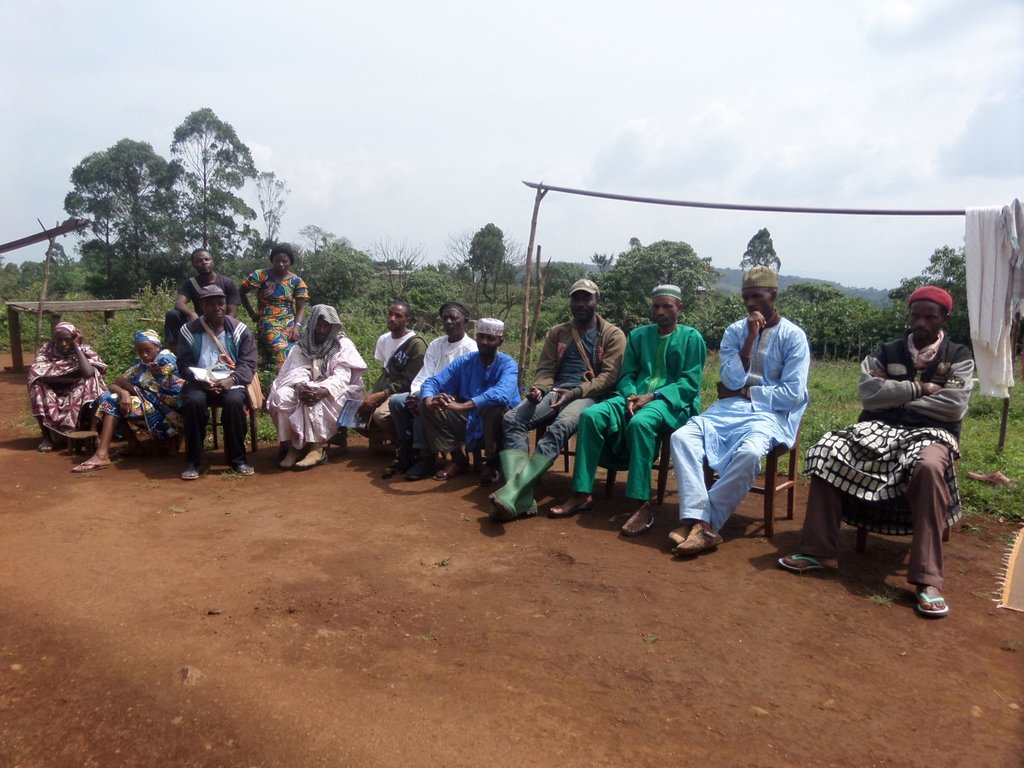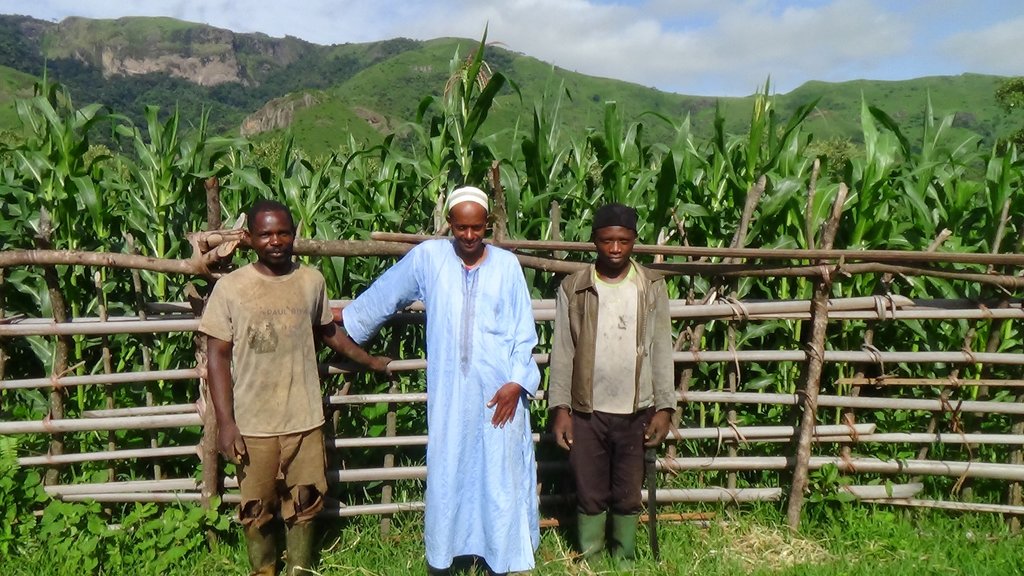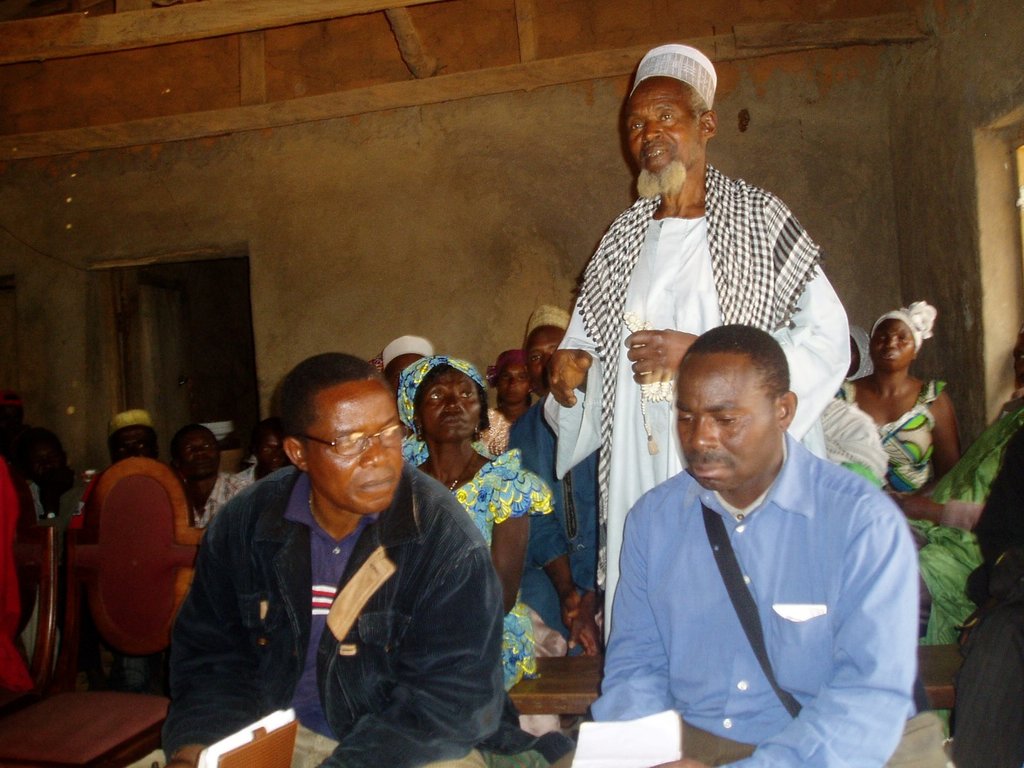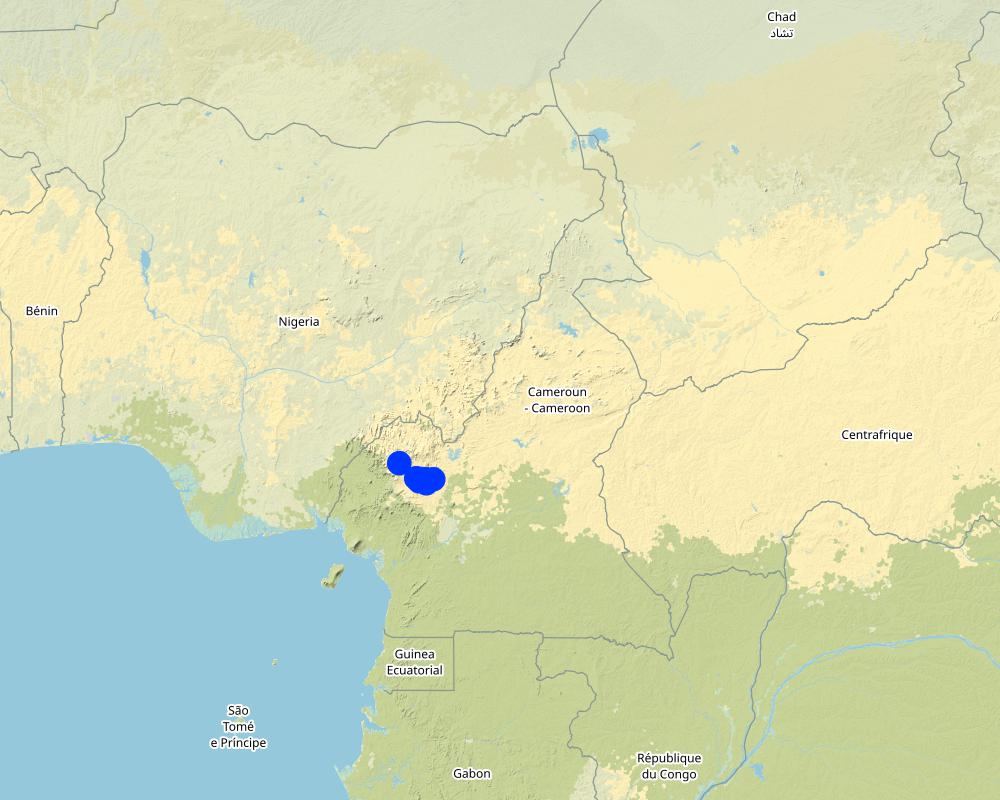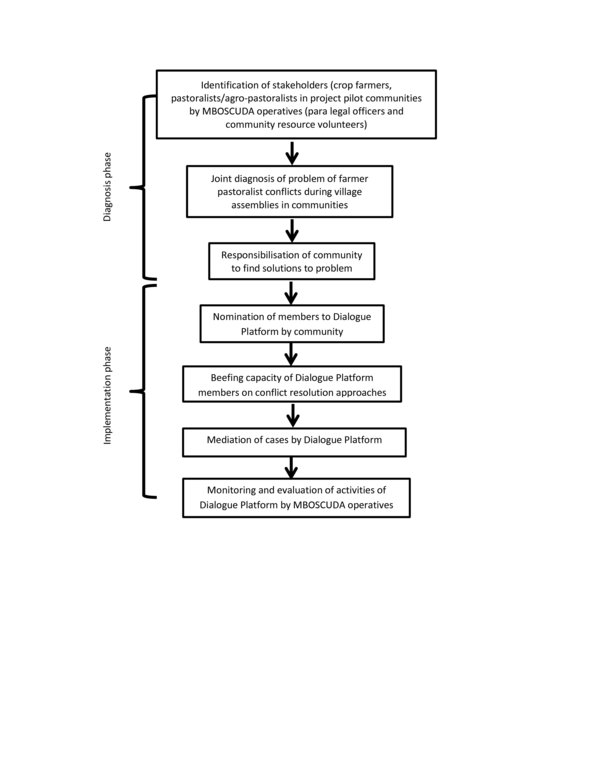Promoting farmers and pastoralists consultations in managing rangelands. [Cameroon]
- Creation:
- Update:
- Compiler: Blasius Azuhnwi
- Editor: –
- Reviewers: Rima Mekdaschi Studer, Joana Eichenberger
Dialogue platforms
approaches_3319 - Cameroon
View sections
Expand all Collapse all1. General information
1.2 Contact details of resource persons and institutions involved in the assessment and documentation of the Approach
Name of project which facilitated the documentation/ evaluation of the Approach (if relevant)
In Search of Common GroundName of project which facilitated the documentation/ evaluation of the Approach (if relevant)
Book project: Guidelines to Rangeland Management in Sub-Saharan Africa (Rangeland Management)Name of the institution(s) which facilitated the documentation/ evaluation of the Approach (if relevant)
Mbororo Social and Cultural Development Association (MBOSCUDA) - Cameroon1.3 Conditions regarding the use of data documented through WOCAT
When were the data compiled (in the field)?
16/11/2017
The compiler and key resource person(s) accept the conditions regarding the use of data documented through WOCAT:
Yes
1.4 Reference(s) to Questionnaire(s) on SLM Technologies
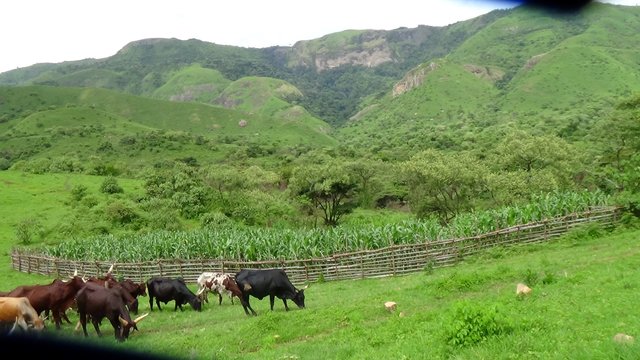
Alliance Farming [Cameroon]
Alliance farming refers to collaboration between crop farmers and pastoralists, who agree to use the same land and related resources (crop residues as fodder for pastoralists; dung as fertilizer for crop farmers) for their mutual benefit.
- Compiler: Blasius Azuhnwi
2. Description of the SLM Approach
2.1 Short description of the Approach
Dialogue platforms bring together rangeland users including farmers, pastoralists/agro pastoralists to learn, discuss and implement low stake conflict mitigation strategies and mutually beneficial alliances.
2.2 Detailed description of the Approach
Detailed description of the Approach:
Dialogue Platforms (DP) are usually made up of between 12 to 14 community members with a balance from pastoralist and farming communities. Members are selected from within the community on the basis of their track records on peace building, objectivity and interest in the development of their community. The objectives of these platforms include: promoting: inter-community dialogue in natural resources sharing and access; sensible resource management; and both mutual beneficial relationships and constructive conflict resolution and mitigation. The Alternative Conflict Management (ACM) approach is generally used and this seeks to address the question of how people can make better decisions together, particularly on difficult, contentious issues. This is implemented as an alternative to more adversarial or non-consensual strategies, such as judicial or legal recourse, unilaterally initiated public information campaigns or partisan political action.
The stages of this multi-stakeholder dialogue process mainly facilitated by 'Paralegals' and 'Community Resource Volunteers' of the Mbororo Social and Cultural Development Association (MBOSCUDA) are as follows:
1. Identification of stakeholders who are mainly farmers, pastoralists and agro pastoralists but may also include representatives of traditional authorities, the local administration and technical services
2. Awareness-raising about the approach
3. Setting-up of the DP and capacity building of members in conflict mediation techniques of the Alternative Crisis Management (ACM) approach, which stresses negotiation and mediation in resolving resource access/use conflicts
4. Monitoring of the functioning of the DP
5. Promoting the emergence of beneficial production relations between farmers and pastoralists
2.3 Photos of the Approach
2.4 Videos of the Approach
Comments, short description:
'Reaching the Unreached': https://www.youtube.com/watch?v=gBUXSDnVLUM
A documentary showing some of MBOSCUDA's community development initiatives in North-West Cameroon.
Date:
12.12.2012
Location:
North-West Cameroon
Name of videographer:
ISCG project of MBOSCUDA
2.5 Country/ region/ locations where the Approach has been applied
Country:
Cameroon
Region/ State/ Province:
North West Region
Further specification of location:
This approach has been piloted in 23 communities in the North West Region.
Map
×2.6 Dates of initiation and termination of the Approach
Indicate year of initiation:
2011
Year of termination (if Approach is no longer applied):
2018
Comments:
Project funding will end in 2018. Some aspects of this approach have been existing informally within the communities but through the facilitation efforts of development NGOs, it has gained in popularity and has even made its way in to the draft Pastoral Code of the country awaiting enactment by parliament.
2.7 Type of Approach
- project/ programme based
2.8 Main aims/ objectives of the Approach
- Articulation and mediation of different interests in resource use and sharing.
- Promotion of beneficial relationships.
- Sustainable resource (land and water) management.
- Constructive conflict resolution.
2.9 Conditions enabling or hindering implementation of the Technology/ Technologies applied under the Approach
social/ cultural/ religious norms and values
- hindering
Cultural differences between two main land user (pastoralists and crop farmers) may hinder smooth functioning of approach. Pastoralists are predominantly Moslems while farmers are Christians. So possibilities of clashes over religious values e.g. Moslems don't drink alcohol or eat pork which may be served during gatherings.
availability/ access to financial resources and services
- hindering
This approach does not depend on availability/access to financial resources and services.
institutional setting
- hindering
Presently the institution set up by law at the level of every sub division to adjudicate farmer-pastoralists' a conflict is the Agro-Pastoral Commissions (APC) which have been dubbed as corrupt and inefficient in handling these conflicts. Some are even known to help perpetuate these conflicts for their selfish ends. The members of these APCs may see in this new approach the end of their prerogatives, since conflicts will no longer be brought to them as farmers and pastoralists try to settle their conflicts amongst themselves without recourse to a third party.
collaboration/ coordination of actors
- enabling
The success of this approach is critically hinged on collaboration between the main local actors - usually farmers and pastoralists - and also the facilitation skills of the 'Paralegals' and 'Community Resource Volunteers' of MBOSCUDA, the community-based organization facilitating the emergence of this approach.
- hindering
Absence of collaboration between the main local actors (farmers and pastoralists) will greatly hinder the smooth functioning of dialogue platforms.
legal framework (land tenure, land and water use rights)
- enabling
This approach has yet to get formal backing from the state. This formal backing can only come when it is recognised in the state laws.
policies
- hindering
Too much reliance on animal health care to the detriment of rangelands science and governance in government policy. This pre-dates independence and even continues up to recent times where efforts have been oriented towards the reinforcement of veterinary infrastructure, with little concern about facilitating the emergence of structures at the local level for negotiating multiple and complementary uses of resources.
land governance (decision-making, implementation and enforcement)
- enabling
This decentralization of decision- making, implementation and enforcement creates an enabling atmosphere for the emergence of community dialogue platforms. Also, the land tenure system of the country is under review and it is hoped that the draft provisions creating and recognizing dialogue platforms will be maintained.
knowledge about SLM, access to technical support
- enabling
The presence of paralegals and 'community resource volunteers' from MBOSCUDA, a local community-based organization, facilitates the emergence of dialogue platforms. They provide support in terms of training and backstopping, and also carry out monitoring and evaluation.
markets (to purchase inputs, sell products) and prices
- enabling
n.a. since this is an institutional measure.
- hindering
n.a. since this is an institutional measure.
workload, availability of manpower
- hindering
The DP members render their services pro bono (free of charge). This calls for extra effort and sacrifice on their part. They can be hindered in offering these services if they also have their own private and personal matters to attend to, such as working in their fields to tend crops or animals.
3. Participation and roles of stakeholders involved
3.1 Stakeholders involved in the Approach and their roles
- local land users/ local communities
Rangeland users: pastoralists and farmers.
Pastoralists and farmers drawn from the communities, because of their integrity, constitute members of dialogue platforms. They look into conflicts presented to them by local people to mediate and find low stake solutions for them.
- community-based organizations
Mbororo Social, Cultural and Development Association (MBOSCUDA).
Facilitated the emergence of this approach by organising and sponsoring capacity building workshops for DP members through their consultants and also paralegals and community resource volunteers, who closely follow-up the functioning of DPs.
- SLM specialists/ agricultural advisers
Consultants .
Consultants were brought in to train DP members in conflict management, leadership skills and group dynamics.
- researchers
Researchers.
Compiling and documentation of practice.
- national government (planners, decision-makers)
Cameroon government.
Called upon to recognize/formalize this low stake conflict mediation/resolution approach.
- international organization
SNV Netherlands Development Organisation. Village Aid - a UK based charity. Comic Relief - UK based charity.
Department of International Development (DFID) UK.
Provision of funding for programme activities.
3.2 Involvement of local land users/ local communities in the different phases of the Approach
| Involvement of local land users/ local communities | Specify who was involved and describe activities | |
|---|---|---|
| initiation/ motivation | interactive | Because of the endemic conflicts over resource use and access in the community, the local people saw the setting- up of DP as a felt need. So local people, together with MBOSCUDA operatives, jointly analysed the situation and came up with the need to create DPs as a low stake solution to resolving farmer-pastoralists conflicts without the involvement of administrative, judiciary and law enforcement officials who were seen instead to be inefficient and corrupt. |
| planning | interactive | Joint planning sessions between local people and MBOSCUDA operatives were held to map out activities. Locals then designated members from their communities to serve as DPs, and these members were supposed to be of high standing in the communities. |
| implementation | interactive | Activities are implemented by DP members with support from MBOSCUDA operatives (paralegals and Community Resource Volunteers). |
| monitoring/ evaluation | external support | For now the monitoring/evaluation of DPs is done by Community Resource Volunteers supported by MBOSCUDA with a fuel allowance to go round and backstop the functioning of DPs. |
3.3 Flow chart (if available)
Description:
During a village or quarter assembly convened by traditional authorities and facilitated by MBOSCUDA operatives, the conflicting relationship between farmers and pastoralists is discussed and participants undertake a firm commitment to work towards improving it. The idea of a dialogue platform as a low stake measure in mitigating and resolving resource access/use is presented and community support and recognition is solicited. Community members are then called upon to designate members (between 12- 14 in number, and with at least 2 to 3 women and youths) to make up a DP for the village/quarter. The DP members are then capacitated to carry out their duties through short courses in conflict management and leadership skills, group dynamics and the existing legal framework on land tenure. They go ahead with carrying out their duties which are then monitored by MBOSCUDA operatives. The improved dialogue in the community - especially between farmers and pastoralists - then fosters the forming of farming alliances between the two groups.
Author:
Blasius Azuhnwi
3.4 Decision-making on the selection of SLM Technology/ Technologies
Specify who decided on the selection of the Technology/ Technologies to be implemented:
- land users alone (self-initiative)
Explain:
The land users (farmers and pastoralists) spontaneously decide to form alliances among themselves based on their affinities, location etc
4. Technical support, capacity building, and knowledge management
4.1 Capacity building/ training
Was training provided to land users/ other stakeholders?
Yes
Specify who was trained:
- land users
- field staff/ advisers
If relevant, specify gender, age, status, ethnicity, etc.
Dialogue Platform members of both sexes who are generally adults of high and proven standing drawn from the community.
Form of training:
- on-the-job
- courses
Subjects covered:
- Conflict Management.
- Mediation Skills.
- Leadership Skills
- Group Dynamics.
- Existing legal framework.
Comments:
The capacity of field staff and advisers who basically are the paralegals and community resource volunteers were beefed up with these trainings as well.
4.2 Advisory service
Do land users have access to an advisory service?
Yes
Specify whether advisory service is provided:
- on land users' fields
- at permanent centres
Describe/ comments:
Follow-up by MBOSCUDA operatives in the farmers' fields to see the effectiveness of conflict resolution outcomes arrived at by DPs.
4.3 Institution strengthening (organizational development)
Have institutions been established or strengthened through the Approach?
- yes, greatly
Specify the level(s) at which institutions have been strengthened or established:
- local
Describe institution, roles and responsibilities, members, etc.
The Dialogue Platform members’ capacities have been built on resolving conflicts.
MBOSCUDA's (Mbororo Social and Cultural Development Association) capacity has been built to function as a better community grassroots support organisation.
Specify type of support:
- capacity building/ training
Give further details:
These refresher courses gave participants the opportunity to share best practices and identify key weaknesses in mediating farmer-herder conflicts.
4.4 Monitoring and evaluation
Is monitoring and evaluation part of the Approach?
Yes
Comments:
A conflict database to ensure effective monitoring of the outcomes of the project and capture trends of conflicts in the Region has been put in place and hosted by MBOSCUDA.
If yes, is this documentation intended to be used for monitoring and evaluation?
Yes
Comments:
This database is updated on a trimester basis with information which DP members give paralegals and community resource volunteers. They intend collate and pass it on to Regional Agro-pastoral Officer at the MBOSCUDA's (Mbororo Social and Cultural Development Association) regional office in Bamenda where the data base is hosted.
4.5 Research
Was research part of the Approach?
No
5. Financing and external material support
5.1 Annual budget for the SLM component of the Approach
If precise annual budget is not known, indicate range:
- 10,000-100,000
Comments (e.g. main sources of funding/ major donors):
This has been mainly from international charities and donors such as: mainly Big Lottery Fund through Village Aid but also other UK charities e.g. United Purpose; Front line Defenders; Comic Relief; Guernsey Overseas Aid Commission; Charles Heywood Foundation and Evan Cornish Foundation but also individuals e.g. Veronica Wigley and Oliver Maxwell Sawyer of the UK.
5.2 Financial/ material support provided to land users
Did land users receive financial/ material support for implementing the Technology/ Technologies?
Yes
If yes, specify type(s) of support, conditions, and provider(s):
This was mostly in terms of stationery (files, paper, pen and papers) for the functioning of DPs provided by MBOSCUDA. This stationery is mostly used in documenting the proceedings and outcome of DPs mediation efforts.
5.3 Subsidies for specific inputs (including labour)
- equipment
| Specify which inputs were subsidised | To which extent | Specify subsidies |
|---|---|---|
| tools | fully financed | Didactic material (files, rim of papers, pen and papers) |
If labour by land users was a substantial input, was it:
- voluntary
Comments:
The services of DP members is on pro bono basis. .
5.4 Credit
Was credit provided under the Approach for SLM activities?
No
5.5 Other incentives or instruments
Were other incentives or instruments used to promote implementation of SLM Technologies?
No
6. Impact analysis and concluding statements
6.1 Impacts of the Approach
Did the Approach empower local land users, improve stakeholder participation?
- No
- Yes, little
- Yes, moderately
- Yes, greatly
This approach has greatly empowered local land users who increasingly do not have to turn to third parties (traditional authorities, administrative and judicial authorities or law and enforcement officers) to adjudicate in land use conflicts but seek recourse in Dialogue Platforms.
Did the Approach enable evidence-based decision-making?
- No
- Yes, little
- Yes, moderately
- Yes, greatly
Decisions are being made at the local level by Dialogue Platform members who are in tune with the local realities
Did the Approach help land users to implement and maintain SLM Technologies?
- No
- Yes, little
- Yes, moderately
- Yes, greatly
An interesting and beneficial outcome of DPs has been the emergence of stronger integrated farming systems, strengthening synergies between crop farmers and pastoralists known locally as “Alliance Farming” which is win-win for both crop farmers and pastoralists.
n.a
Did the Approach improve knowledge and capacities of land users to implement SLM?
- No
- Yes, little
- Yes, moderately
- Yes, greatly
From the farming alliances that have developed as an outcome of the implementation of this approach, community members are engaging in more sustainable ways of growing crops, as farmers make use of dung and urine from cattle and don't have to rely only on chemical fertilizers.
Did the Approach improve knowledge and capacities of other stakeholders?
- No
- Yes, little
- Yes, moderately
- Yes, greatly
Capacities were considerably improved through the courses that the various stakeholders received; the conflicts that the DPs resolved in practice, considerably improved their capacities
Did the Approach build/ strengthen institutions, collaboration between stakeholders?
- No
- Yes, little
- Yes, moderately
- Yes, greatly
Conflicts between land users have decreased in numbers, frequency and intensity as community members have come to see the need for mutual co-existence of two farming or land use systems (crop farming and livestock production).
Did the Approach mitigate conflicts?
- No
- Yes, little
- Yes, moderately
- Yes, greatly
Conflicts have considerably decreased in project communities.
Did the Approach empower socially and economically disadvantaged groups?
- No
- Yes, little
- Yes, moderately
- Yes, greatly
The Mbororos who are the cattle- rearers have come to gain in confidence and overcome the low self-esteem they had in themselves, and also the poor perception other communities had of them.
Did the Approach improve gender equality and empower women and girls?
- No
- Yes, little
- Yes, moderately
- Yes, greatly
For inclusiveness, it is statutory that at least 3 members of the Dialogue Platform are women. This is particular important in Mbororo communities where women face double marginalization - for being women and for living in predominantly patriarchal societies, and also for being pastoralists who still live on the fringes of society.
Did the Approach encourage young people/ the next generation of land users to engage in SLM?
- No
- Yes, little
- Yes, moderately
- Yes, greatly
For inclusiveness, youths are statutory members of dialogue platforms.
Did the Approach improve issues of land tenure/ user rights that hindered implementation of SLM Technologies?
- No
- Yes, little
- Yes, moderately
- Yes, greatly
Pastoralists’ rights have been strengthened by this approach. The rights they have over the rangelands they inhabit and use for their livelihood were mostly usufruct rights, but farmers increasingly through this approach and its related technology - the Alliance Farming - acknowledge the other rights (such as right of management) that pastoralists have over the rangelands they inhabit. They are no longer looked upon as 'strangers' by farming neighbours because of their late settlement in the North West Region of the country.
Did the Approach lead to improved food security/ improved nutrition?
- No
- Yes, little
- Yes, moderately
- Yes, greatly
With the improved social climate between pastoralists and farmers, more time can be devoted to agriculture.
n.a.
Did the Approach lead to improved access to water and sanitation?
- No
- Yes, little
- Yes, moderately
- Yes, greatly
The improved social climate has led to community members jointly engaging in projects such as catchment area protection for water supplies.
Did the Approach lead to more sustainable use/ sources of energy?
- No
- Yes, little
- Yes, moderately
- Yes, greatly
Biogas use by community members has increased as some of dung is used as input for the biogas plants which generate energy for domestic use.
Did the Approach lead to employment, income opportunities?
- No
- Yes, little
- Yes, moderately
- Yes, greatly
Community members, because of reduced conflicts, have time to gainfully engage themselves in their farm enterprises, diversify their livelihood options as well such as engage in other business activities.
6.2 Main motivation of land users to implement SLM
- increased production
Stronger integrated farming systems strengthening synergies between crop farming and pastoralism.
- conflict mitigation
Resolving conflicts which were preventing harmonious co-existence between the two land use forms, the farmers and pastoralists.
6.3 Sustainability of Approach activities
Can the land users sustain what has been implemented through the Approach (without external support)?
- yes
If yes, describe how:
A present trend observed is where farmers and pastoralists go ahead to resolve conflicts among themselves even without the intervention of DPs - indicating that the approach is sustainable.
6.4 Strengths/ advantages of the Approach
| Strengths/ advantages/ opportunities in the land user’s view |
|---|
| It has opened up dialogue between farming and pastoral communities, who for the most part were “at daggers drawn”. This has improved social cohesion between the two, as seen in the emergence of mutual beneficial farming alliances between farmers and pastoralists. |
| In cases of compensation for crop damage or injury/death of animals, this is handed to the victim and not to administrative or judiciary authorities as is the case with the Agro-Pastoral Commissions, the statutory institution that arbitrates conflicts between farmers and pastoralists. |
| It has allowed them the possibility of avoiding uncertainty, time, cost and stress in going through the Agro-Pastoral Commissions or the courts. |
| Strengths/ advantages/ opportunities in the compiler’s or other key resource person’s view |
|---|
| Low stake conflict prevention/ resolution mechanism compared to the present one involving the intervention of administrative, judiciary or law enforcement officials which has proved to be ineffective and fraught with corruption. It is workable, affordable and adaptable to local realities. |
| It has created an enabling environment for the emergence of mutually beneficial farming relationships and considerably reduced the hostility between the two major land users - pastoralists and farmers. |
| Quite informal, voluntary and flexible. |
6.5 Weaknesses/ disadvantages of the Approach and ways of overcoming them
| Weaknesses/ disadvantages/ risks in the land user’s view | How can they be overcome? |
|---|---|
| DP members will want some form of compensation for their time and effort. | Putting in place a local mechanism to help compensate DP members for their time and effort. |
| Weaknesses/ disadvantages/ risks in the compiler’s or other key resource person’s view | How can they be overcome? |
|---|---|
| Not yet recognized by law and so decisions taken by DPs are not legally binding. | Recognition and or formalization will go a long way to make them legally binding. |
7. References and links
7.1 Methods/ sources of information
- field visits, field surveys
Observations during field visits.
- interviews with land users
Collected the views of about 30 different farmers and pastoralists during field visits to DP sites in focus group interviews.
- interviews with SLM specialists/ experts
Conducted interviews with 4 SRM specialists at MBOSCUDA on 5 different occasions.
- compilation from reports and other existing documentation
7.2 References to available publications
Title, author, year, ISBN:
Breakthrough (A publication of MBOSCUDA vols 1,2,3 and 4
Available from where? Costs?
Free from MBOSCUDA office
Title, author, year, ISBN:
Making Rangelands More Secure in Cameroon, ILC Rangelands Series, Issue Paper 8, by Blasius Azuhnwi
Available from where? Costs?
Free from ILC Rome
Title, author, year, ISBN:
Mid Term Evaluation Report of 'In Search of Common Ground' for Farmer-Grazer Conflicts in the North West Region of Cameroon. August 2016 by Nchinda Valentine, Che Marcellus, Tata Precillia Ijang, Shidiki Abubakar & Chi Napoleon
Available from where? Costs?
Free from MBOSCUDA
7.3 Links to relevant information which is available online
Title/ description:
Website of Mbororo Social and Cultural Development Association (MBOSCUDA)
URL:
http://www.mboscuda.org/
Links and modules
Expand all Collapse allLinks

Alliance Farming [Cameroon]
Alliance farming refers to collaboration between crop farmers and pastoralists, who agree to use the same land and related resources (crop residues as fodder for pastoralists; dung as fertilizer for crop farmers) for their mutual benefit.
- Compiler: Blasius Azuhnwi
Modules
No modules



